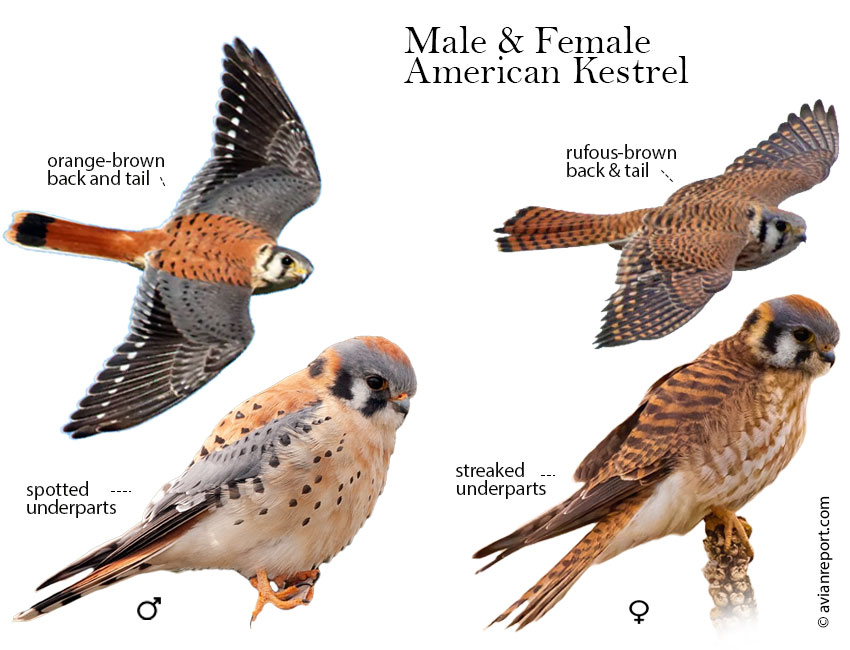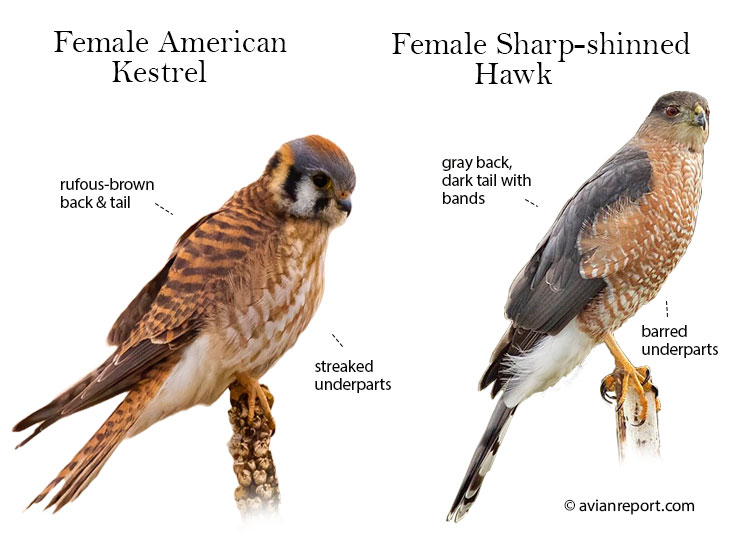Introducing the distinct female American Kestrel, adorned in rufous-brown plumage, setting her apart from the vibrant male counterpart. Whether you’ve observed her perched on a fence post or you’re a seasoned birder deciphering subtle clues that distinguish her not only from the male but also from the often-confused Sharp-shinned Hawk, this is an article for you. Get ready for a comprehensive comparison between the female American Kestrel, the male, and the similar-looking Sharp-shinned Hawk.
American Kestrel female

American Kestrel
Habitat
Breeding
Feeding
Migration
Calls & Sounds
Female Kestrel
Kestrel vs Merlin
Kestrel vs Sharp-shinned Hawk
Kestrels: Southeast
*******************
The female American Kestrel has a subdued yet elegant appearance, characterized by rufous-brown tones. She has an slender and agile figure.
The upperparts, including the back, wing coverts, and tail, showcase rufous-brown feathers with black bars. The tail typically follows a similar pattern to the back, featuring black bars and a narrow subterminal black band.
The head is patterned with two distinctive black stripes on the sides of the head, blue-gray top of the head with a rufous crown.
The underparts, including the the breast, belly, and flanks are buffy, with a lighter throat, and prominently streaked with brown.
Female vs. Male American Kestrel
The male American Kestrel shows a more vibrant and striking plumage. Its back exhibits brighter orange-brown tones barred with black. The wings showcase contrasting blue-gray tones.
The tail is bright orange-brown mostly unbarred except for the outer pairs. The tail features a distinctive black subterminal band.
The underparts vary from pale buff to pinkish or orange, with variable streaking and spotting often concentrated on the sides of the breast and upper belly.
Both, male and female kestrels have a patterned head. They have blue-gray top of the head with a rufous crown. Both sexes exhibit two black stripes on the sides of the head, but the male’s stripes are bolder and more defined.

For a clearer visualization of the plumage differences, I have created a table comparing the plumage of the American Kestrel female with that of the male.
| Feature | American Kestrel Female | American Kestrel Male |
| Back: | Rufous-brown tones: A blend of earthy hues, intricately barred with black. | Orange-brown tones: A vibrant orange-brown back with thick black barring. |
| Wings: | Rufous-brown similar to the back. The black barring is mixed with black spotting. | Blue gray wings that sharply contrast with the orange-brown color of the back. |
| Head: | Patterned head: Blue-gray top, rufous crown and black stripes on the sides of head. | Patterned head: Similar to that of the female with bolder black stripes on both sides of the head. |
| Breast and Underparts: | Light buff streaked with brown. Density of streaks is variable. | Buff to light orange with a varying amount of streaks and bold dots, concentrated on the sides of the chest and belly. |
| Tail: | Long narrow rufous-brown feathers with black barring and a black band near the tip of the tail. | Orange-brown unbarred except for the outer pairs. Bold black band near the tip of the tail. |
American Kestrel Female vs Sharp-shinned Hawk
In discussions with birder friends regarding confusing bird in the field, the comparison between a female American Kestrel and a Sharp-shinned Hawk (Accipiter striatus) was raised. In this section, I outline some differences that will make distinguishing these two raptors in the field a breeze.
Size
Before we embark on a comparison between these two raptors, we need to bring up the fact that there is a size difference between the male and female Sharp-shinned hawk. Female Sharp-shinned hawks are 20 to 25% larger than the males.
In ascending order an American Kestrel is the smallest of the three followed by the male Sharp-shinned Hawk and the largest of the the three, the female Sharp-shinned Hawk.
Shape
The American kestrels may overlap in size with the male Sharp-shinned Hawk, their shapes are different. Kestrels look more graceful and slender, an effect perhaps created by the proportionally longer-tailed kestrel.
Hunting Technique
The female American Kestrel is a sit and weight hunter. It sits in high perches or vantage points to scan the ground below for unsuspecting insects, lizards, and small birds. In open areas that lack suitable perches, the female kestrel hovers in mid air to spot a prey on the ground and swoop down to catch it.
Sharp-shinned hawks ambush, nearly exclusively, small birds inside follieage or semi-open woodlands. One would never see a Sharp-shinned Hawk sitting on a high perch in an open habitat scanning the ground with short vegetation below. Likewise, one would never see a Sharp-shinned Hawk hovering in open habitats.
Plumage

The female American Kestrel has a rufous-brown back barred with black and buff underparts with brown streaks.
The Sharp-shinned hawk has a solid gray top of the head and back and a dark tail. The underparts are densely barred with orange-brown.
Table comparing the Female American Kestrel with a Sharp-shinned hawk
Let’s take a closer look at the differences between these two hunters.
| Feature | American Kestrel Female | Sharp-shinned Hawk |
| Overall Tone: | Lighter colors dominated by rusty brown and pale underparts. | Darker and muted tones with orange-brown underparts. |
| Size: | Male and female weight 4.3 oz on average. | Male and female weight 5.4 oz on average. Females are larger than males. |
| Back: | Rufous-brown barred with black. | Back and wings solid gray. |
| Wings: | Rusty-brown barred with black. | Same as back, solid gray. |
| Head: | Patterned, black stripes on sides of the head. | Gray crown with grayish-brown sides of the head. |
| Underparts: | Buff streaked with brown. | Densely barred with orange-brown. |
| Tail: | Rusty-brown feathers barred with black. | Gray with thick black bands. |
HABITAT
In separating the American Kestrel female and the Sharp-shinned Hawk, one of the most reliable clues is their habitat preferences and hunting techniques. The female American Kestrel favors open habitats with short vegetation and scattered perches. The Sharp-shinned Hawk is an interior forest bird.
| Feature | Female American Kestrel | Sharp-shinned Hawk |
| Preferred Habitat: | Open spaces: loves fields, meadows, farmland, and edges of woodlands. Perches on fence posts, wires, or low trees. | Prefers denser cover with trees and shrubs. Thrives in forests, woodlands, parks, and even backyards. |
| Hunting Style: | Patient sit-and-wait-predator: scans the ground from high perches, then dives or swoops silently to snatch grasshoppers, lizards, and even small birds. | Agile acrobat: darts through dense foliage, chasing and surprising smaller birds like songbirds, sparrows, and finches. |
| Prey Preferences: | Opportunistic eater: diet varies depending on availability, but often targets insects, grasshoppers, small rodents, and lizards. | Bird specialist: primarily focused on hunting smaller birds. Occasionally small mammals and reptiles. |
| Hunting Adaptations: | Sharp vision: boasts incredible eyesight to spot prey from afar. | Sharp talons for swift grabs of prey. Broad round wings for quick maneuvering through foliage. |
These are general tendencies, and both birds can adjust their tactics and prey choices based on their surroundings and season. But with this knowledge, you’ll be better equipped to interpret their habitat choices and make a positive identification.
Related: Read more about the comparison between the American Kestrel and Sharp-shinned Hawk.
Conclusions:
- Female American Kestrel Appearance:
- Subdued rufous-brown plumage with black bars on upperparts.
- Buffy breast, belly, and flanks with prominent streaks.
- Slender and agile stature.
- Female vs. Male American Kestrel:
- Male showcases vibrant orange-brown back with blue-gray wings.
- Bright orange-rufous tail with a distinctive black subterminal band.
- Underparts vary from pale buff to orange with dots.
- Both sexes have a patterned head with bolder stripes in males.
- Female American kestrel vs Sharp-shinned Hawk:
- Size and Shape: Kestrels are smaller and more graceful, while Sharp-shinned Hawks are the largest.
- Hunting Technique: Kestrels use sit-and-wait and hovering, while Sharp-shinned Hawks ambush in foliage.
- Plumage: Kestrels have rusty-brown back, while Sharp-shinned Hawks have solid gray and orange-brown streaks.
Habitat: Kestrels prefer open spaces, Sharp-shinned Hawks thrive in dense foliage.
References
- Johnsgard, P. 1990. Hawks, Eagles, and Falcons of North America. United States: Smithsonian Institution.
- Smallwood, J. A. and D. M. Bird (2020). American Kestrel (Falco sparverius), version 1.0. In Birds of the World (A. F. Poole and F. B. Gill, Editors). Cornell Lab of Ornithology, Ithaca, NY, USA.
Author: